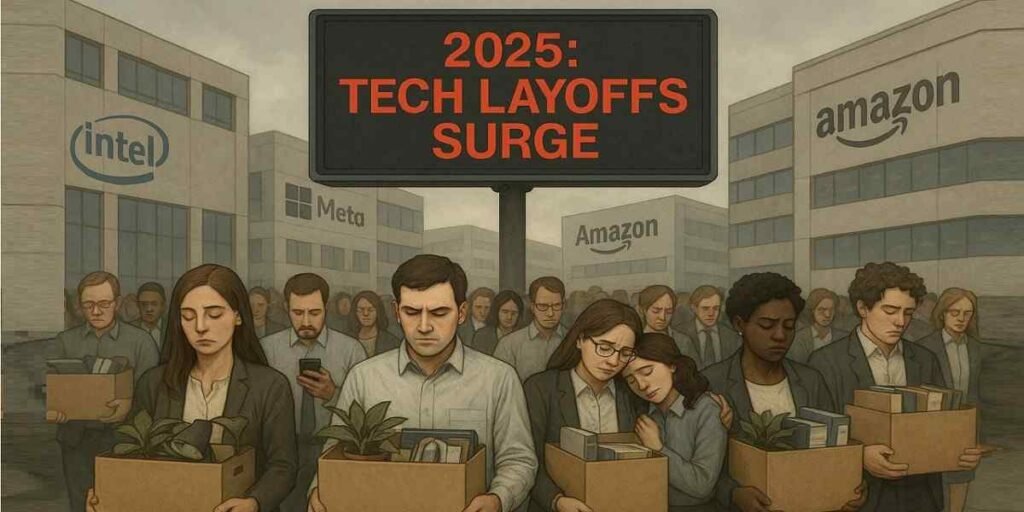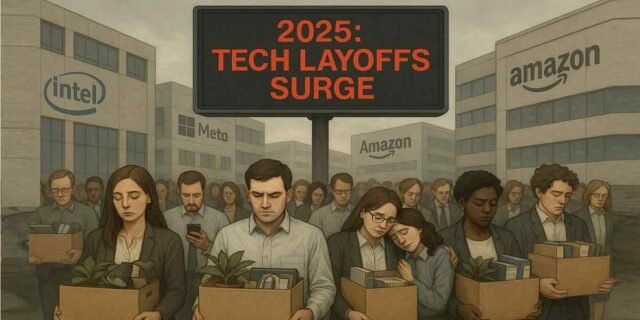In what is fast becoming a landmark moment for the tech sector, global tech layoffs 2025 have reached staggering levels: more than 112,700 roles cut across 218 companies worldwide. According to data from Layoffs.fyi, this wave of job cuts underlines a broader transformation — one where companies are reducing headcount and redirecting resources into artificial intelligence and cloud computing.
The casualties of these cuts span roles once thought secure: mid-level management, product specialists, and service functions are increasingly being replaced or reshaped. For workers in Lagos, Abuja, Johannesburg, London or San Francisco, the message is clear — the old models of tech employment are changing, and fast.
For many individuals I spoke with, the moment carries a heavy personal weight. One former senior product manager at a major U.S. firm told me, “I was told my role wouldn’t evolve into the AI strategy function. They were hiring new people instead.” It’s a scenario now repeating across continents.

Table of Contents
What’s driving the wave of global tech layoffs in 2025?
Several interlocking trends are propelling this surge in job cuts:
1. Pandemic-era expansion meets post-pandemic reality. Many tech firms ramped up hiring aggressively during the pandemic, anticipating permanent shifts in work, commerce and digital services. Now, as growth slows and budget pressure mounts, those expansions are being reversed
2. AI transformation as the key pivot. Investment in generative AI, automation of customer support, and increased reliance on cloud infrastructure are ushering in new capabilities — and rendering some traditional roles redundant. For example:
- Amazon announced cuts of up to 30,000 jobs, including about 14,000 in corporate roles, as the firm shifts to “run like the world’s largest startup”.
- Intel plans to shed 24,000 jobs — nearly 22 % of its workforce — as it reorganises around semiconductor and foundry divisions.
- India’s Tata Consultancy Services (TCS) effected its steepest job reduction ever: 19,755 roles were cut in the quarter ending September 2025. The cuts targeted mid- and senior-level professionals as the firm pivots toward AI-led efficiency.
3. Globalisation of the job-cut wave. While grounded in the largest tech hubs, the job losses are not confined to the U.S. or India. Firms across Europe, Latin America and Africa are equally involved — meaning that the ripple effect is global, impacting talent markets everywhere.
4. Changing business models and cost discipline. With capital becoming more expensive and growth returns diminishing, firms say they need leaner operations, more agile structures and stronger alignment with the next generation of technology. Ignoring cost discipline is no longer an option.
Who is being affected — and where do opportunities lie?
In the midst of these sweeping changes, it’s vital to understand who’s being impacted and where opportunities may still exist — especially for tech workers in Africa and developing economies.
Affected groups:
- Mid-level and senior professionals whose roles were once deemed “strategic” but are now being considered expendable in AI-driven re-organisations.
- Service and customer-support roles, especially within global firms, are being automated as AI takes over repetitive tasks.
- Roles in legacy tech domains (e.g., PC hardware, some manufacturing and traditional software) as demand wanes and business models shift.
Potential growth areas:
- AI specialists, machine learning engineers, cloud-infrastructure experts and data-centric roles are increasingly in demand. Where companies are cutting traditional roles, they are investing in these futuristic functions.
- Regions and talent markets that can offer cost-effective but high-quality support for cloud and AI services may find new opportunities. For example, tech hubs in Africa might benefit if they align their educational base with these new demand vectors.
- Freelance and gig-based roles tied to AI-data, prompt engineering and cloud operations may grow faster than traditional full-time roles, offering flexibility and agility in uncertain times.
Insights from Nigeria and Africa:
In Nigeria’s tech ecosystem, the churn is being felt both in local operations of global firms and in the start-up community. While the numbers may be smaller compared to the big U.S. players, the trend of re-prioritising tech capability is very real. Tech talent here must stay agile — acquiring new AI, cloud and data-science skills, and being ready to re-position themselves in a changing environment.

What these layoffs mean for the future of work in tech and beyond
The phenomenon of global tech layoffs in 2025 is more than a short-term disruption. It signals a deeper structural shift in how tech companies deploy talent, how roles are defined, and how work is organised. Here are key implications:
Long-term structural adjustment, not just temporary correction. While market cycles have always seen layoffs, the current wave is different in that it is embedded in a broader transition — to AI, automation and new service models. Companies are rethinking job functions rather than just trimming costs.
The human dimension: role humility and upskilling. From my conversations with workers displaced in this round, one consistent theme emerges: roles once seen as secure are now vulnerable. What matters now is adaptability, readiness to reskill and understanding that your job title may evolve or disappear. That personal story matters — as do the emotional, financial and professional impacts on individuals.
Geographic implications: talent flows may change. With automation reducing the need for large regional support centres, some regions may see slower growth in traditional outsourcing jobs. Conversely, regions that build capability in new tech may leap ahead. For Nigeria, Ghana, Kenya and other African hubs, this means an imperative to invest in STEM education, cloud skills and AI literacy now.
Corporate responsibility and transition support. As companies proceed with cuts, the need for responsible practices becomes more visible. Supporting displaced employees with retraining, internal mobility and severance planning becomes part of reputational and operational responsibility. If companies ignore the human story, they risk deeper workforce morale issues and talent flight.
Policy and social safety nets will be tested. As large numbers of tech workers face disruption, the social and economic policy environment will matter. For nations where tech has been a growth engine, ensuring that workers are protected and that new pathways exist will be critical — or else the human cost will escalate.

Conclusion: navigating global tech layoffs 2025 with purpose
The wave of global tech layoffs 2025 may feel overwhelming — and for many individuals, it is. But within the challenge lies an opportunity: to redefine how we think about work in tech, to evolve skillsets, and to locate new pathways.
As someone who has watched tech talent levels and company strategies shift over years, the central message is this: your job title is not the final form — it’s the platform for your next evolution. Whether you’re in Lagos managing a small team, in Nairobi designing cloud infrastructure, or in Abuja contemplating a career pivot, competence in AI, cloud, data and agility will matter more than ever.
For companies, this moment is also instructive: the cost of ignoring people is high. Whichever path you take — whether you’re leading a major firm or building a local start-up — the human side of transformation must be central. Layoffs do not just reflect cost savings; they reflect strategy, values and future ambition.
In the end, the phrase global tech layoffs 2025 will sit not just in headlines but in the lived experience of thousands of professionals. It tells a story of change, disruption — yes — but also of renewal, adaptation and the next chapter for tech talent everywhere.
As the dust settles, the smart move is to lean into learning, build for tomorrow’s demands and ensure that the story isn’t just about loss but about reinvention. And in that sense, the countdown doesn’t end with the cuts — it starts with what comes next.
Join Our Social Media Channels:
WhatsApp: NaijaEyes
Facebook: NaijaEyes
Twitter: NaijaEyes
Instagram: NaijaEyes
TikTok: NaijaEyes





